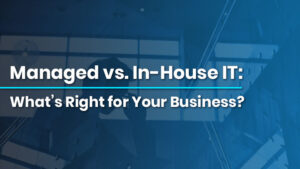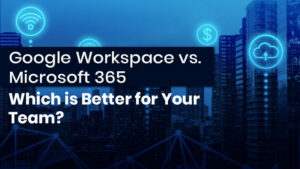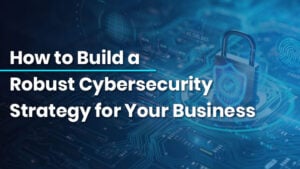
Managed vs. In-House IT: What’s Right for Your Business?
Managed vs. In-House IT: What’s Right for Your Business? Introduction Technology is no longer a support function but a key enabler of innovation, scalability, and
🔥 Limited Time Offer 🔥 Get the Premium Monthly Plan for just $11.99 $19.99. Use code UPSKILLNOW and unlock exclusive benefits 👉Subscribe Now!

Managed vs. In-House IT: What’s Right for Your Business? Introduction Technology is no longer a support function but a key enabler of innovation, scalability, and

Google Workspace vs. Microsoft 365: Which is Better for Your Team? Introduction Choosing the right productivity suite is essential for any business aiming to

How to Build a Robust Cybersecurity Strategy for Your Business Introduction In the modern digital landscape, cybersecurity is no longer just an IT concern,
Table of Contents
The Internet of Things (IoT) is a pivotal force in IT/OT convergence, reshaping how organizations integrate and leverage their information technology (IT) and operational technology (OT) systems. By connecting devices with sensors and actuators, IoT bridges the gap between the digital and physical worlds, enabling real-time data collection and control that drive operational efficiency and innovation. In this guide, we explore the benefits, challenges, and real-world applications of IT/OT convergence.
Ready to harness the power of IT/OT convergence for your organization? Contact IPSpecialist to explore our IT certification courses that can help you integrate and optimize your IT and OT systems, leveraging the full potential of IoT technology.
| Aspect | Information Technology (IT) | Operational Technology (OT) |
| Definition | Technology used for managing and utilizing data within an organization | Technology used to control and manage physical assets |
| Focus | Data storage, processing, and communication | Physical processes and machinery control |
| Components | Servers, computers, applications, networks | Manufacturing machinery, HVAC systems, vehicles, industrial equipment |
| Personnel | IT professionals (e.g., network administrators, system engineers) | OT professionals (e.g., field technicians, control engineers) |
| Primary Goal | Efficient data management and analysis | Effective control and monitoring of physical operations |
| Data Handling | Primarily digital and abstract data | Primarily sensor data and physical process metrics |
| Integration | Integrates with business applications, databases, and communication systems | Integrates with machinery, control systems, and process automation |
| Examples | Enterprise Resource Planning (ERP) systems, cloud storage, email servers | SCADA systems, PLCs, industrial control systems |
| Security | Focuses on data protection, cybersecurity, and network security | Focuses on physical security, system reliability, and process safety |
| Automation | Automates data processing, reporting, and communication | Automates machinery control, process adjustments, and monitoring |
Data integration combines IT and OT data into a unified platform, enhancing decision-making by providing a comprehensive view of operations. For example, merging ERP systems with SCADA systems enables more informed decisions and improved efficiency.
System integration ensures seamless communication between IT and OT systems, such as linking building management systems with enterprise systems. This coordination enhances operational harmony and supports organizational goals.
Process integration aligns IT and OT processes to optimize workflows, such as synchronizing IT-driven scheduling with OT-driven production. This improves productivity and reduces delays.
Security integration provides a unified approach to cybersecurity for both IT and OT domains, protecting against vulnerabilities and ensuring operational integrity.
Communication integration uses standardized protocols to enable effective interaction between IT infrastructure and industrial controllers, ensuring smooth data exchange and operational coordination.
Management integration combines IT and OT management practices, offering a comprehensive view of both IT infrastructure and OT performance through integrated dashboards.
Automation integration merges IT and OT automation systems to enhance efficiency, such as triggering IT processes based on OT data, improving response times and operational agility.
Cloud integration uses cloud services to manage and analyze IT and OT data, providing valuable insights and enhancing data management and innovation through cloud-based tools.
IT/OT convergence offers significant technological advancements and opportunities across industries. But how can you determine if IT/OT convergence is right for your business? And if it is, how can you successfully implement it?
With proper planning, businesses of all sizes can integrate IT and OT systems effectively. To avoid common pitfalls, it’s crucial to train employees in IT/OT systems before introducing new technology. Ensuring that your team is well-prepared can prevent disruptions and optimize the benefits of convergence. Additionally, partnering with a qualified IoT administrator who has relevant certifications in IoT management can facilitate a smoother integration process, ensuring that your IT/OT convergence strategy is both effective and sustainable.
IT/OT convergence represents a pivotal shift in how businesses operate, merging Information Technology with Operational Technology through the Internet of Things (IoT) to drive efficiency, automation, and real-time insights. This integration facilitates predictive maintenance, cost savings, and streamlined operations, though it comes with challenges like siloed processes, security risks, and integration complexities. Embracing IT/OT convergence not only optimizes current operations but also positions businesses to adapt and thrive in a digital future.
IT/OT convergence is the integration of Information Technology (IT) systems with Operational Technology (OT) systems through the Internet of Things (IoT). This convergence is crucial because it allows organizations to automate processes, gain real-time insights, and improve operational efficiency. By merging these traditionally separate systems, businesses can enhance visibility into their operations, predict equipment maintenance needs, and reduce costs.
Key challenges include overcoming siloed processes and expertise between IT and OT departments, addressing security vulnerabilities of IoT devices, ensuring seamless system integration, and managing diverse IoT connectivity solutions. Effective IT/OT convergence requires cross-departmental collaboration, robust security measures, and integration strategies to manage and analyze data from various sources.
Businesses can leverage IT/OT convergence by utilizing real-time data for predictive maintenance, automating routine processes to reduce costs, and optimizing resource management. This approach enables new service models and pricing structures based on equipment performance. Companies can also improve operational agility and responsiveness, positioning themselves to adapt to market changes and technological advancements more effectively.
© 2025 All rights reserved | Privacy Policy | Terms and Conditions | Sitemap | Cookie Policy




